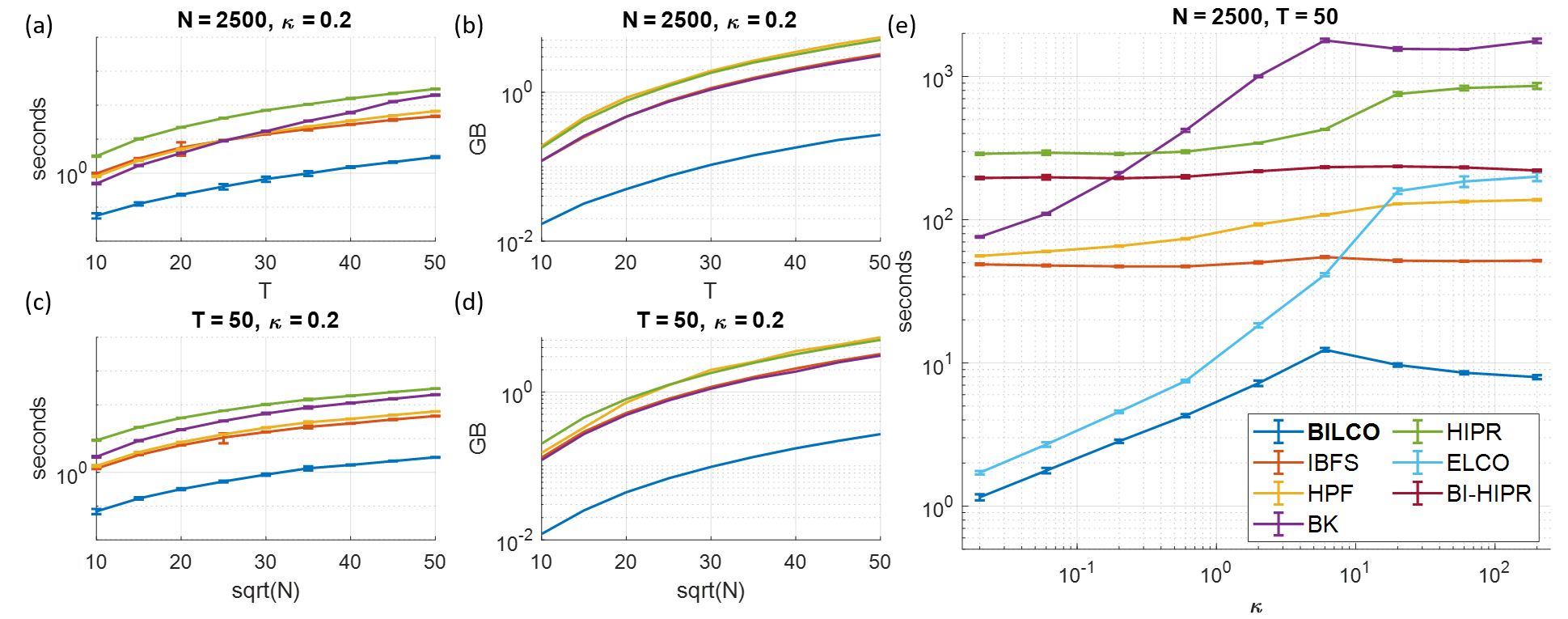BILCO (BIdirectional pushing with Linear Component Operations) is an efficient algorithm for solving joint alignment problem and min-cut for GTW (graphical time warping) graph. BILCO has the same theoretical time complexity as the best popular methods such as HIPR (highest-label push-relabel), but it provides a significant empirical efficiency boost without sacrificing the accuracy in the task of joint alignment. On thousands of datasets under various simulated scenarios and three real applications in distinct categories, BILCO could show around 10 to 50 times speed improvement and only cost 1/10 memory compared with the best one among peer methods IBFS (incremental breadth-first search), HPF (Hochbaum's pseudoflow), BK (Boykov-kolmogorov), and HIPR.
If you have any feedback or issue, you are welcome to either post them or send email to yug@vt.edu or mixl18@vt.edu (Guoqiang Yu and Xuelong Mi at Virginia Tech).
BILCO is implemented in C++ language with a MATLAB wrapper. The repository contains:
- demo.m --------------- A simple version of BILCO. The code is short and easy to understand.
- BILCO.m -------------- The MATLAB wrapper of BILCO.
- BILCOMex.cpp --------- C++ code for BILCO.
- referenced_methods --- Peer methods with MATLAB wrapper.
- experiments_data ----- Real data in three applications mentioned in the paper.
The joint alignment problem can be formulated as
where
As shown, the equation can be converted to a flow network and solved by finding the min-cut of it.
The constructed graph, GTW graph, consisting of
BILCO contains two major parts, ELCO and bidirectional pushing.
ELCO use the component as the basic operation unit and majorly consists of two component operations: Drain and Discharge. (Each component is a subset of GTW subgraph bounded by two adjacent cuts). It can be described as follows: Initially, each subgraph is one active component. "Drain" operation sends maximum excess directly to the sink through edges within subgraph. A new cut will be generated, which blocks some excess in the segmented components near the source. Then it is the turn of "Discharge" to seek opportunities to move excess across subgraph toward components that can execute "Drain". By executing these two component operations, the global max-flow can be achieved. The whole framework is like the progress of pumping water from multiple water tanks.
An analogy to joint alignment max-flow problem. Water, tube, tank, and partition represent excess, cross edge, subgraph, and cut, respectively. (a) In the initial stage, the source has pushed all water it can to water tanks. (b) ``Drain'' operation: water in the tanks is drained to sink. (c) ``Discharge'' operation: water flows from an active component to a neighbor component in another water tank, where water needs to concentrate at the connecting tube first. (d) After (c), the previously inactive component in $G_2$ becomes active and water can be drained again. Due to the concentration step in (c), there is one new partition in $G_1$ that further segments it into three components. (e) One intermediate stage of a tank, where multiple components are segmented in a subgraph and some tubes are blocked.Bidirectional-pushing stategy utilizes the easy-obtained initialization. It segments the original graph according to the initialization and then push excess and deficit in two opposite directions. Through such strategy, it can avoid some meaningless and redundant computation for push-relabel based methods.
- Initialization: Estimate initial cut
$C_0$ for GTW graph. The corresponding source side and sink side are denoted as$V_{S_0}$ and$V_{T_0}$ , respectively. - Push excess: Replace all the nodes in
$V_{S_0}$ by source, solve the max-flow problem by pushing excess. The new sink side segmented by the new min-cut$C_1$ is denoted as$V_{T_1}$ . - Push deficit: Replace all the nodes in
$V_{T_1}$ by sink, solve the max-flow problem of the graph by pushing deficit. The obtained min-cut$C_2$ is the min-cut of the original GTW graph.
The time complexity of BILCO is
We compared our approach to two different peer methods on both synthetic and real data.
We simulated an image signal propagation dataset with varying
pixels (
Here we compare our BILCO with four peer methods in three distinct application categories: calculating signal propagation, extracting depth information, and signature identification. Since all these max-flow methods would give the same results, here we only compare running time and memory usage, as shown in Table. \ref{Table:real}, where in the name represents the spatially downsampled data.
Xuelong Mi, Mengfan Wang, Alex Bo-Yuan Chen, Jing-Xuan Lim, Yizhi Wang, Misha Ahrens, Guoqiang Yu BILCO: An Efficient Algorithm for Joint Alignment of Time Series, NeurIPS 2022





